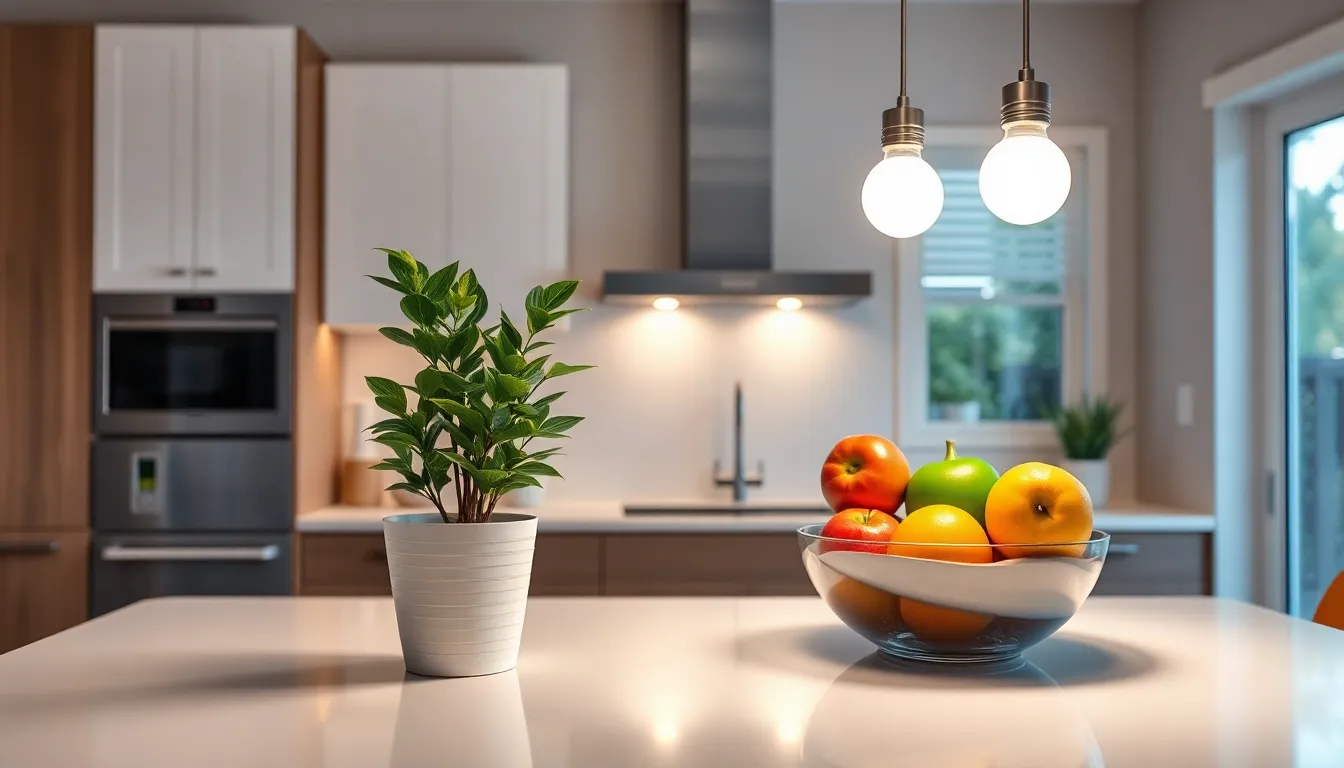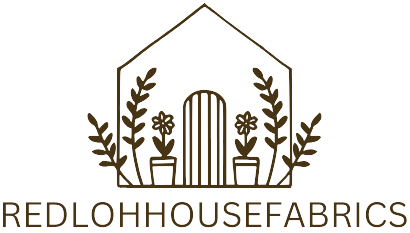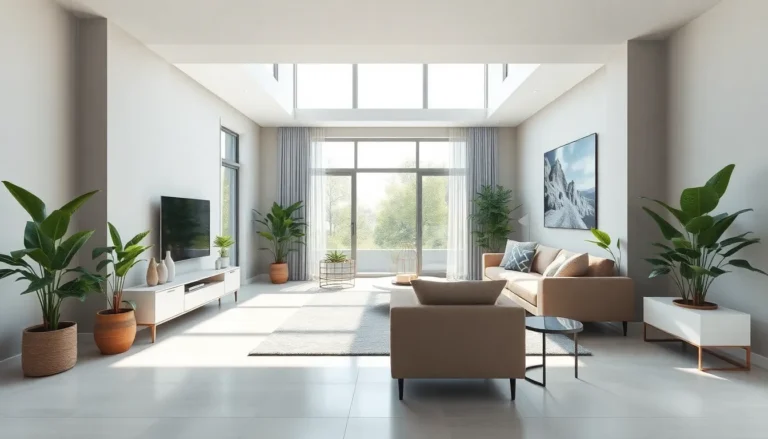Table of Contents
ToggleIn a world increasingly focused on sustainability, energy efficient lighting stands out as a smart choice for both homes and businesses. It not only reduces energy consumption but also lowers electricity bills, making it an appealing option for budget-conscious consumers. With advancements in technology, lighting solutions like LED and CFL bulbs have become more accessible and effective than ever.
Switching to energy efficient lighting isn’t just about saving money; it also contributes to a healthier environment. By using less energy, these lighting options help decrease greenhouse gas emissions and reliance on fossil fuels. As more individuals and organizations embrace this change, the benefits extend beyond personal savings to a collective impact on the planet’s future.
Overview Of Energy Efficient Lighting
Energy efficient lighting significantly reduces energy consumption and enhances economic savings. This lighting type is essential for sustainable practices in both residential and commercial settings.
Definition And Importance
Energy efficient lighting refers to light sources that use less electricity while providing the same or greater illumination than traditional incandescent bulbs. This lighting reduces energy costs, minimizes environmental impact, and decreases reliance on non-renewable resources. By lowering electricity use, energy efficient lighting helps lower greenhouse gas emissions, contributing to a healthier atmosphere and supporting climate change mitigation efforts.
Types Of Energy Efficient Lighting
- LED Bulbs: LED (Light Emitting Diode) bulbs use approximately 75% less energy than incandescent bulbs, lasting 25 times longer. They emit less heat and offer a variety of color temperatures.
- CFL Bulbs: Compact Fluorescent Lamps (CFL) consume about 70% less energy than incandescent bulbs and last up to ten times longer. They produce a soft light and come in multiple sizes.
- Halogen Bulbs: Halogen bulbs utilize a small amount of energy compared to traditional incandescent lighting. They have a longer lifespan and provide brighter light, making them suitable for various applications.
- Smart Lighting: Smart lighting systems can adjust brightness and color based on user preferences or room occupancy. These systems enhance energy efficiency through automation and control.
- Solar-Powered Lighting: Solar-powered lights draw energy from sunlight and require no electrical wiring, making them ideal for outdoor use. They contribute to energy savings by utilizing renewable energy sources.
Benefits Of Energy Efficient Lighting

Energy efficient lighting offers significant advantages for both individuals and the environment. Below are key benefits including cost savings and environmental impact.
Cost Savings
Cost savings represent one of the most immediate benefits of energy efficient lighting. LED bulbs consume about 75% less energy than traditional incandescent bulbs, resulting in reduced electricity bills. For example, switching to LED lighting can save households over $100 annually. CFL bulbs also provide savings, as they use approximately 70% less energy and last up to ten times longer, minimizing replacement costs. Smart lighting systems further enhance savings by optimizing usage through automation, allowing for additional energy conservation.
Environmental Impact
Environmental impact highlights the sustainability benefits of energy efficient lighting. By reducing energy consumption, these lighting options contribute to lower greenhouse gas emissions. LED and CFL bulbs can prevent the release of over 1,000 pounds of carbon dioxide per bulb throughout their lifespan. Furthermore, utilizing solar-powered lighting harnesses renewable energy, decreasing reliance on fossil fuels. This collective shift towards energy efficient solutions supports climate change mitigation and fosters a healthier planet for future generations.
Comparison Of Popular Lighting Options
Various lighting options exist, each with unique characteristics and efficiency ratings. Here’s a detailed comparison of LED, CFL, and incandescent lighting.
LED Lighting
LED lighting provides substantial energy savings and durability, using approximately 75% less energy than traditional incandescent bulbs. LED bulbs last up to 25 times longer, reducing replacement frequency and overall waste. These bulbs offer instant brightness and come in a range of colors and designs, making them versatile for any application. Additionally, they generate minimal heat, contributing to lower cooling costs in warmer environments.
CFL Lighting
CFL lighting, or compact fluorescent lamps, consume about 70% less energy than incandescent bulbs. They typically last up to 10 times longer, which lowers the need for frequent bulb changes. CFLs require a brief warm-up period to reach full brightness but offer a range of shapes and sizes suitable for different fixtures. While CFLs contain a small amount of mercury, they still generate less greenhouse gas than incandescent lighting over their lifespan, supporting environmental sustainability.
Incandescent Lighting
Incandescent lighting is less energy efficient compared to LED and CFL options, consuming about 90% more energy to produce the same amount of light. Their average lifespan is around 1,000 hours, significantly shorter than LED and CFL bulbs. Incandescent bulbs emit a warm light and reach full brightness instantly but contribute to higher electricity bills and increased environmental impact due to their short life and high energy consumption. Transitioning away from incandescent lighting is crucial for energy conservation efforts.
Tips For Choosing The Right Energy Efficient Lighting
Selecting the appropriate energy efficient lighting requires consideration of various factors that ensure optimal performance and savings. The following tips provide guidance for making informed choices.
Consider Your Space
Evaluate the size and purpose of the space before choosing lighting. Large areas such as living rooms or commercial spaces benefit from higher lumen output for adequate illumination. Smaller spaces, like closets or hallways, require less light. Assess the color scheme as well; warm white light enhances cozy atmospheres, while cool white light is better suited for task-oriented environments like kitchens or home offices. Placement also influences effectiveness; consider fixtures that provide direct lighting for tasks and ambient lighting for comfort.
Check for Certifications
Confirm that lights meet energy efficiency standards by checking for certifications. Look for the ENERGY STAR label, which identifies products that outperform traditional lighting options in energy consumption and performance. Other certifications, such as the Lighting Facts label, provide essential details on brightness, energy use, and longevity. Choosing certified products ensures compliance with efficiency guidelines, leading to lower energy bills and an environmentally responsible choice.
Embracing energy efficient lighting is a crucial step toward a sustainable future. By choosing options like LED and CFL bulbs, individuals and businesses can significantly reduce energy consumption while enjoying cost savings. These lighting solutions not only enhance illumination but also play a vital role in minimizing environmental impact.
The transition to more efficient lighting systems fosters a healthier planet for generations to come. With advancements in technology such as smart lighting and solar-powered options, the potential for energy conservation continues to grow. Making informed choices about lighting can lead to a brighter and more sustainable tomorrow.


